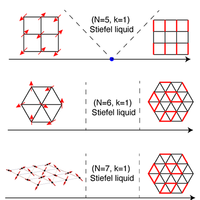Abstract
We propose a new type of quantum liquids, dubbed Stiefel liquids, based on ()-dimensional nonlinear sigma models on target space , supplemented with Wess-Zumino-Witten terms. We argue that the Stiefel liquids form a class of critical quantum liquids with extraordinary properties, such as large emergent symmetries, a cascade structure, and nontrivial quantum anomalies. We show that the well-known deconfined quantum critical point and Dirac spin liquid are unified as two special examples of Stiefel liquids, and , respectively. Furthermore, we conjecture that Stiefel liquids with are non-Lagrangian, in the sense that under renormalization group they flow to infrared (conformally invariant) fixed points that cannot be described by any renormalizable continuum Lagrangian. Such non-Lagrangian states are beyond the paradigm of parton gauge mean-field theory familiar in the study of exotic quantum liquids in condensed matter physics. The intrinsic absence of (conventional or partonlike) mean-field construction also means that, within the traditional approaches, will be difficult to decide whether a non-Lagrangian state can actually emerge from a specific UV system (such as a lattice spin system). For this purpose we hypothesize that a quantum state is emergible from a lattice system if its quantum anomalies match with the constraints from the (generalized) Lieb-Schultz-Mattis theorems. Based on this hypothesis, we find that some of the non-Lagrangian Stiefel liquids can indeed be realized in frustrated quantum spin systems, for example, on triangular or kagome lattice, through the intertwinement between noncoplanar magnetic orders and valence-bond-solid orders.
- Received 31 January 2021
- Revised 10 June 2021
- Accepted 30 June 2021
DOI:https://doi.org/10.1103/PhysRevX.11.031043
Published by the American Physical Society under the terms of the Creative Commons Attribution 4.0 International license. Further distribution of this work must maintain attribution to the author(s) and the published article’s title, journal citation, and DOI.
Published by the American Physical Society
Physics Subject Headings (PhySH)
Popular Summary
To date, most, if not all, known quantum states relevant to the studies of quantum matter can be described by the framework of renormalizable quantum field theories, that is, quantum field theories constructed of particles that are weakly interacting when they are close to each other. An important question is, are there quantum states that cannot be captured by this framework? Here, we suggest there are.
Specifically, we propose an infinite family of novel quantum states. These states, we argue, are “quantum critical,” meaning that they possess intricate structures of quantum entanglement so that they can serve as parent states of many other states—perturbing them results in other states. Perhaps what is most remarkable is that these novel states appear to be non-Lagrangian: They cannot be described by renormalizable quantum field theories but only by nonrenormalizable ones. Furthermore, we argue that these states can arise in experimentally relevant systems because of the competition between intertwined symmetry-breaking orders.
This work raises the interesting possibility that non-Lagrangian quantum states can emerge in realistic quantum matter, challenging the established framework to understand these states, and opening a whole new landscape of quantum states to be explored.



